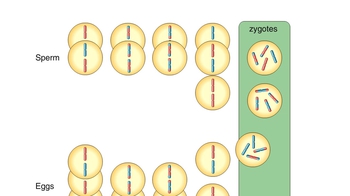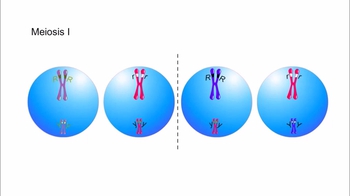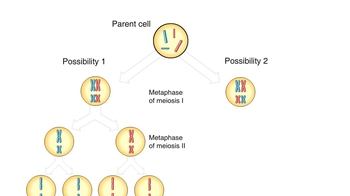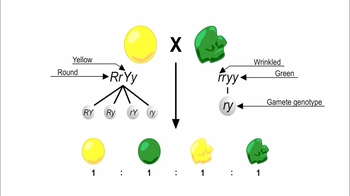Table of contents
- 1. Introduction to Biology2h 42m
- 2. Chemistry3h 40m
- 3. Water1h 26m
- 4. Biomolecules2h 23m
- 5. Cell Components2h 26m
- 6. The Membrane2h 31m
- 7. Energy and Metabolism2h 0m
- 8. Respiration2h 40m
- 9. Photosynthesis2h 49m
- 10. Cell Signaling59m
- 11. Cell Division2h 47m
- 12. Meiosis2h 0m
- 13. Mendelian Genetics4h 44m
- Introduction to Mendel's Experiments7m
- Genotype vs. Phenotype17m
- Punnett Squares13m
- Mendel's Experiments26m
- Mendel's Laws18m
- Monohybrid Crosses19m
- Test Crosses14m
- Dihybrid Crosses20m
- Punnett Square Probability26m
- Incomplete Dominance vs. Codominance20m
- Epistasis7m
- Non-Mendelian Genetics12m
- Pedigrees6m
- Autosomal Inheritance21m
- Sex-Linked Inheritance43m
- X-Inactivation9m
- 14. DNA Synthesis2h 27m
- 15. Gene Expression3h 20m
- 16. Regulation of Expression3h 31m
- Introduction to Regulation of Gene Expression13m
- Prokaryotic Gene Regulation via Operons27m
- The Lac Operon21m
- Glucose's Impact on Lac Operon25m
- The Trp Operon20m
- Review of the Lac Operon & Trp Operon11m
- Introduction to Eukaryotic Gene Regulation9m
- Eukaryotic Chromatin Modifications16m
- Eukaryotic Transcriptional Control22m
- Eukaryotic Post-Transcriptional Regulation28m
- Eukaryotic Post-Translational Regulation13m
- 17. Viruses37m
- 18. Biotechnology2h 58m
- 19. Genomics17m
- 20. Development1h 5m
- 21. Evolution3h 1m
- 22. Evolution of Populations3h 52m
- 23. Speciation1h 37m
- 24. History of Life on Earth2h 6m
- 25. Phylogeny2h 31m
- 26. Prokaryotes4h 59m
- 27. Protists1h 12m
- 28. Plants1h 22m
- 29. Fungi36m
- 30. Overview of Animals34m
- 31. Invertebrates1h 2m
- 32. Vertebrates50m
- 33. Plant Anatomy1h 3m
- 34. Vascular Plant Transport1h 2m
- 35. Soil37m
- 36. Plant Reproduction47m
- 37. Plant Sensation and Response1h 9m
- 38. Animal Form and Function1h 19m
- 39. Digestive System1h 10m
- 40. Circulatory System1h 57m
- 41. Immune System1h 12m
- 42. Osmoregulation and Excretion50m
- 43. Endocrine System1h 4m
- 44. Animal Reproduction1h 2m
- 45. Nervous System1h 55m
- 46. Sensory Systems46m
- 47. Muscle Systems23m
- 48. Ecology3h 11m
- Introduction to Ecology20m
- Biogeography14m
- Earth's Climate Patterns50m
- Introduction to Terrestrial Biomes10m
- Terrestrial Biomes: Near Equator13m
- Terrestrial Biomes: Temperate Regions10m
- Terrestrial Biomes: Northern Regions15m
- Introduction to Aquatic Biomes27m
- Freshwater Aquatic Biomes14m
- Marine Aquatic Biomes13m
- 49. Animal Behavior28m
- 50. Population Ecology3h 41m
- Introduction to Population Ecology28m
- Population Sampling Methods23m
- Life History12m
- Population Demography17m
- Factors Limiting Population Growth14m
- Introduction to Population Growth Models22m
- Linear Population Growth6m
- Exponential Population Growth29m
- Logistic Population Growth32m
- r/K Selection10m
- The Human Population22m
- 51. Community Ecology2h 46m
- Introduction to Community Ecology2m
- Introduction to Community Interactions9m
- Community Interactions: Competition (-/-)38m
- Community Interactions: Exploitation (+/-)23m
- Community Interactions: Mutualism (+/+) & Commensalism (+/0)9m
- Community Structure35m
- Community Dynamics26m
- Geographic Impact on Communities21m
- 52. Ecosystems2h 36m
- 53. Conservation Biology24m
12. Meiosis
Genetic Variation During Meiosis
Problem 11`
Textbook Question
Why are individuals with an extra chromosome 21, which causes Down syndrome, more numerous than individuals with an extra chromosome 3 or chromosome 16? a. There are probably more genes on chromosome 21 than on the others. b. Chromosome 21 is a sex chromosome and chromosomes 3 and 16 are not. c. Down syndrome is not more common, just more serious. d. Extra copies of the other chromosomes are probably fatal.
 Verified step by step guidance
Verified step by step guidance1
Understand the problem: The question is asking why individuals with an extra chromosome 21 (causing Down syndrome) are more numerous compared to individuals with an extra chromosome 3 or 16. The options provided suggest different reasons, and we need to evaluate them based on biological principles.
Step 1: Recall the concept of aneuploidy. Aneuploidy refers to the presence of an abnormal number of chromosomes in a cell. Trisomy is a type of aneuploidy where there is an extra copy of a chromosome (e.g., Trisomy 21 in Down syndrome).
Step 2: Consider the effects of gene dosage. Each chromosome contains many genes, and having an extra copy of a chromosome increases the expression of those genes. This can disrupt normal cellular function. Larger chromosomes (like chromosomes 3 and 16) have more genes, so an extra copy of these chromosomes would likely cause more severe disruptions, potentially leading to early embryonic lethality.
Step 3: Evaluate the options. Option (a) suggests that chromosome 21 has more genes, but this is incorrect because chromosome 21 is one of the smallest human chromosomes. Option (b) is incorrect because chromosome 21 is not a sex chromosome. Option (c) is incorrect because Down syndrome is more common, not just more serious. Option (d) aligns with the idea that extra copies of larger chromosomes (like 3 and 16) are more likely to be fatal due to the higher gene dosage effect.
Step 4: Conclude that the most plausible explanation is option (d): Extra copies of chromosomes 3 and 16 are likely fatal, which is why individuals with Trisomy 21 (Down syndrome) are more numerous.
 Verified video answer for a similar problem:
Verified video answer for a similar problem:This video solution was recommended by our tutors as helpful for the problem above
Video duration:
1mPlay a video:
Was this helpful?
Key Concepts
Here are the essential concepts you must grasp in order to answer the question correctly.
Chromosomal Abnormalities
Chromosomal abnormalities occur when there is a deviation from the normal number or structure of chromosomes. In the case of Down syndrome, individuals have an extra copy of chromosome 21, leading to a total of three copies instead of the usual two. This condition, known as trisomy 21, is one of the most common chromosomal disorders and is associated with various developmental and health challenges.
Recommended video:
Guided course
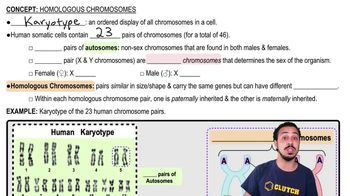
Homologous Chromosomes
Gene Dosage and Viability
Gene dosage refers to the number of copies of a particular gene present in a cell or organism. An extra chromosome can lead to an imbalance in gene dosage, which can disrupt normal development. Chromosomes 3 and 16 contain genes that, when present in excess, may result in severe developmental issues that are often incompatible with life, leading to higher rates of miscarriage or stillbirth compared to trisomy 21.
Recommended video:
Guided course

Genes & Alleles
Prevalence of Down Syndrome
Down syndrome is one of the most prevalent chromosomal disorders, with an incidence of approximately 1 in 700 live births. The relative viability of individuals with trisomy 21 compared to those with other chromosomal trisomies contributes to its higher prevalence. While other trisomies may lead to more severe outcomes, the presence of an extra chromosome 21 allows for a greater number of individuals to survive to birth and beyond.
Recommended video:
Guided course

Building & Breaking-Down Polymers

 7:08m
7:08mWatch next
Master Genetic Variation During Meiosis with a bite sized video explanation from Jason
Start learningRelated Videos
Related Practice






